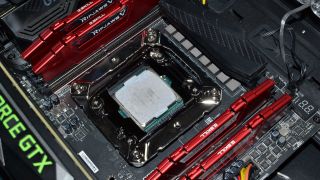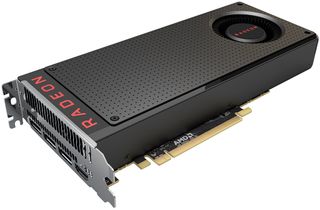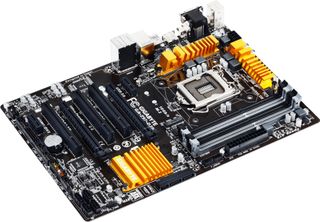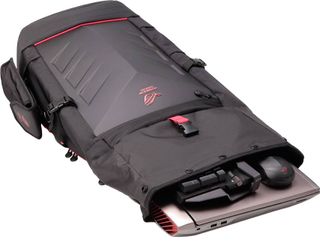The best hardware news this week: GTX 1060, Broadwell E, RX 480
Broadwell-E is benchmarked, a look at how cases are made, and more!

It's been a few weeks since our last weekend update on what's transpired in the world of hardware, but that just means there's plenty of awesome developments. That's true for both CPUs and GPUs, with Broadwell-E being benchmarked and Nvidia offering up mid-range retort to AMD's Radeon RX 480 graphics card.
Beyond major component upgrades, the past few weeks has seen some new peripheral and accessory releases, an interesting vulnerability that affects at least a handful of gaming motherboards, and a look at how computer cases are made, to name some of the highlights.
Enough with the intro, let's recap!
The past two months in hardware news has been insane. Nvidia launched their GTX 1080 and GTX 1070, Intel released Broadwell-E, and AMD launched RX 480. And we're not done yet, as GTX 1060 is coming, along with the Radeon RX 470 and RX 460. Whew! To the matter at hand, while I previewed the high-end 10-core i7-6950X Broadwell-E already, testing of other platforms and CPUs wasn't complete at the time, and I wanted more comparison points. One thing was clear, however, and it's something I want to emphasize: No matter what you might think or hear, the Broadwell-E processors aren't built for gaming enthusiasts.
Wait, what? How can it be that the fastest CPUs that Intel makes aren't for gamers? It's pretty simple, really. Intel split their CPU line into various market segments years ago, with 'professional' Xeon parts intended for workstations and servers on the one hand, and 'consumer' parts (Celeron, Pentium, and various iterations of Core processors) that are intended for typical home users, gamers, and regular business PCs on the other. There are other splits as well, like mobile vs. desktop, but that's a topic for another day. If the difference in naming wasn't enough, Intel took things a step further when they introduced the Core i7 (aka Nehalem) in November 2008.

G.Skill adds new functionality for owners of its KM780 gaming keyboard
PC Gamer Newsletter
Sign up to get the best content of the week, and great gaming deals, as picked by the editors.
Memory and peripheral maker G.Skill announced the release of its latest keyboard software and firmware for the Ripjaws KM780 and KM780R RGB gaming keyboards today.
The update brings an expanded RGB color palette with up to 16 million colors. Any key can be assigned a color using the new palette, including the keyboard's function row and media keys. Previously, the F-key row and media keys were not customizable in G.Skill's software.

Best Buy mixed up prices for RX 480 models
Sometimes retailers slip up, and this time it was Best Buy's turn. AMD's new Radeon RX 480 launched today, and it seems that a few lucky shoppers may have made off with a superior model on the cheap thanks to a pricing error.
When I took a look at BestBuy.com this morning, I found that the retailer had the 8GB RX 480 listed at $200, while the 4GB version was listed at $250. The clear mix-up (or unlikely surprise launch day deal) meant that the 8GB card sold out quickly. As of this writing, Best Buy still had the 4GB model in stock.

2016 is shaping up to be the year of the GPU, with major advancements coming from all corners and at all prices. To recap, Nvidia has their supercomputing Tesla P100 with the GP100 GPU—not something you can currently buy as an individual graphics card, though that's coming later this year, but it's a monster of a chip for those that need it (read: not gamers for the time being). The GP100 represents the pinnacle of GPUs, with an estimated price per Tesla module of $12,000 (give or take). Dropping down from the stratosphere, the new GTX 1080 looks affordable by comparison, sporting a GP104 chip and delivering better-than-Titan X performance at a suggested price of $600-$700—too bad it remains out of stock (or severely overpriced) at most places. Not surprisingly, the GTX 1080's affordable sibling, the GTX 1070, is in a similar state: it's an awesome card that's currently difficult to buy, particularly at anything close to the $380-$450 suggested price range (though Newegg apparently has a few cards listed as being in stock as I write this, so supply may be improving a bit).

AMD Crimson 16.7.1 driver puts Radeon RX 480 PCIe power draw in check
When we reviewed the new RX 480, we found a lot to like, but other sleuths managed to dig a little deeper and found problems, namely: the card was exceeding PCIe spec for power draw. That may sound bad, and it's definitely not good, but in speaking with several motherboard companies, most of them felt it was a non-issue. Regardless, AMD promised to release a driver update that would address the problem, and today AMD has released their Crimson 16.7.1 drivers that address the Radeon RX 480's overzealous power draw.
There were actually two issues related to power, first was pulling too much power from the PCIe slot and exceeding its 75W power limit, but reviewers also found that AMD's introductory Polaris part was sometimes exceeding its rated total power consumption of 150W. That was less of a concern than overdrawing through the PCIe slot connector, but a concern nonetheless.

GeForce 368.69 driver adds support for Dirt Rally VR
While you're waiting for Dirt Rally VR to release for the Oculus Rift, you might as well go grab Nvidia's new Game Ready 368.69 WHQL drivers, assuming you have a GeForce graphics card or GPU.
The new driver package adds support for Dirt Rally's forthcoming virtual reality mode. According to Nvidia, Dirt Rally VR will launch on the Oculus Store July 11, with existing players to receive the update through Steam the same day. HTC Vive owners will also see the VR update, though SteamVR support isn't expected until sometime later this month.

Nvidia’s $250 GeForce GTX 1060 will battle AMD for mid-range supremacy
Nvidia took control of the high-end graphics card sector with the launch of its GeForce GTX 1080 and GTX 1070, a pair of Pascal cards that are each faster than a Titan X, and now it's going after the mid-range segment with its new GeForce GTX 1060.
Also based on Pascal, the GeForce GTX 1060 is a $250 card that Nvidia says is faster than a GeForce GTX 980. Underneath the hood of this mid-range gladiator is a 16nm GP106 GPU wielding 1,280 CUDA cores, down from 1,920 cores in the GTX 1070 and 2,560 in the 1080. That's also less than the 2,048 cores found on the GTX 980, but Nvidia says it can still trump the previous generation Maxwell part thanks to Pascal's architectural improvements, along with faster GPU and memory clocks.

UK consumers to face higher prices for PCs and other tech after Brexit vote
If you’ve been paying attention to global news at all recently, you've read the word 'Brexit' about six million times. The vote that has sent the UK on the road out of the European Union will have many local and global effects for sure, but most immediately relevant to our purview (next to long-term effects on British game development) is that for shoppers in the UK, PCs are going to get a bit pricier.
The day after the referendum vote, the British pound fell like a ton of bricks. In the days following, the pound has hit lows not seen since 1985. And that means higher prices. On Tuesday, The Register reported Dell would be increasing prices by 10 percent for its products in the UK to compensate for the falling value of the pound. Dell’s gaming products include the Alienware and XPS line of products.

Dated Intel code leaves Lenovo laptops and Gigabyte motherboards vulnerable
A security researcher has discovered a nasty flaw that he originally thought only affected Lenovo laptops, but it turns out that's not the case. The critical security vulnerability also affects at least one HP laptop and a handful of Gigabyte motherboards aimed at gamers, including the GA-Z77X-UD5H, GA-Z68-UD3H, GA-Z87MX-D3H, and GA-Z97-D3H.
Dmytro "Cr4sh" Oleksiuk published an exploit for the vulnerability called ThinkPwn without first sharing his findings with Lenovo, PCWorld reports. The exploit can be used to sidestep security features built into Windows and allow an attacker to execute malicious code in the CPU's privileged System Management Mode (SMM).
This is low-level access that could pave a path for a rootkit in a PC's Unified Extensible Firmware Interface (UEFI), and also to disable things like Secure Boot, Virtual Secure Mode, and other Windows security features.

How PC cases are made: inside NZXT's factory Chances are good that most of your PC was built in or around Shenzen, China, a mecca of electronics manufacturing. I took a trip to nearby Dongguan, a short drive outside of Shenzen, to visit a factory your PC definitely came from if it's housed in an NZXT case. This factory, built in 2000, devotes most of its manufacturing energy to NZXT's PC cases, and I got to tour the facility and check out every step of the process.
In the following gallery, I'll dive into how cases are built, how surprisingly manual the assembly line process still is, painting, quality control, assembly, and more.

Rain is no match for monstrous Asus ROG Ranger backpack
Asus is adding a rather large backpack to its growing line of bags and carrying cases covering an assortment of electronics. This newest entry is the ROG Ranger, a large backpack that can swallow up to a 17-inch class laptop while still having room for several accessories.
The ROG Ranger backpack is made from durable, water-resistant 1260D Gucci polyester with a polyurethane panel on the back to provide protection for your gaming gear. Should you happen to find yourself in stormy weather, there's also built-in rain cover that tucks into the bottom to keep your laptop and assorted peripherals dry.

Devialet's new Phantom speaker will bring down your walls
Last month I took an in-depth look at Devialet's incredible speaker, an alien-thing that outputs insane amounts of power and produces deeper bass than most home theater subwoofers. Sure, there are doubters out there, but unless you've heard one, it's difficult to explain just how amazing the Phantom is.
Devialet just announced that my crazy Silver Phantom is no longer the bee's knees of speakers. Today the company introduced its Gold Phantom, which promises to beat the Silver Phantom I reviewed into a pulp.
4500 watts of power, 108 dB SPL of sound pressure, 0.0005% THD, and an impressive frequency range of 14Hz to 27kHz.

Corsair wants you to lighten up with its Vengeance LED DDR4 RAM
Is your rig short on bling? Corsair can help take care of that with its new Vengeance LED DDR4 RAM kits. Available with either red or white LED lighting, each DIMM has pulsing LEDs on the top bar, though there's more here than just a light show.
Corsair says each module is built using a ten-layer high performance PCB for better signaling. It also uses cherry picked ICs that are "carefully screened" to help with overclocking and reliability on Intel X99 and 100 series motherboards. The modules are topped off with finned aluminum heatspreaders and XMP 2.0 profiles.
Paul has been playing PC games and raking his knuckles on computer hardware since the Commodore 64. He does not have any tattoos, but thinks it would be cool to get one that reads LOAD"*",8,1. In his off time, he rides motorcycles and wrestles alligators (only one of those is true).
Most Popular







